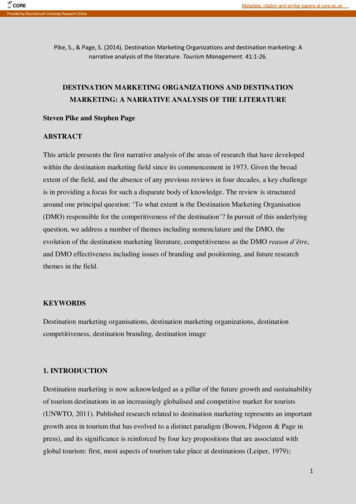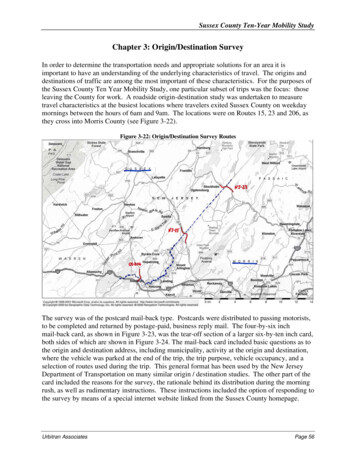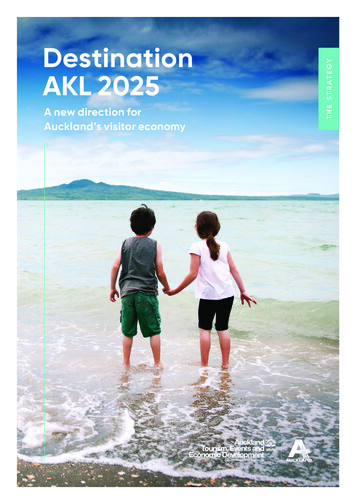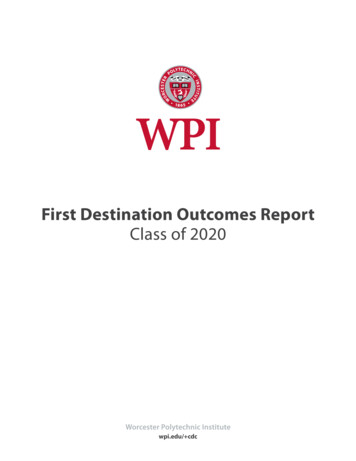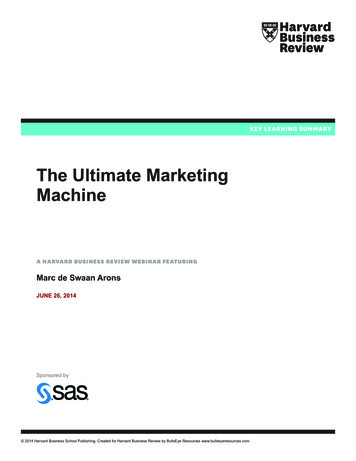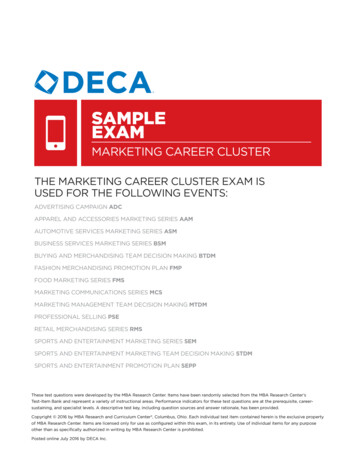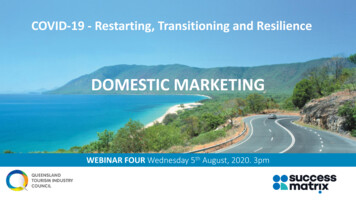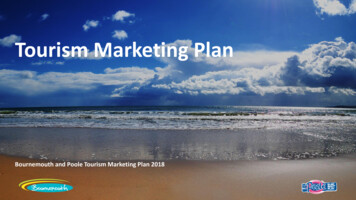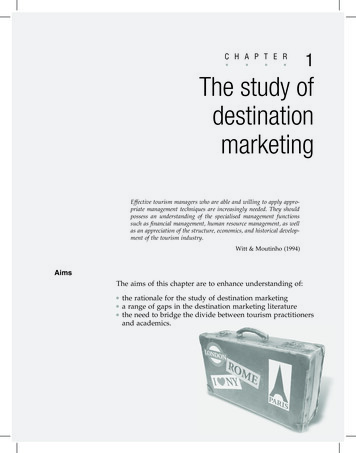
Transcription
C H A P T E R 1The study ofdestinationmarketingEffective tourism managers who are able and willing to apply appropriate management techniques are increasingly needed. They shouldpossess an understanding of the specialised management functionssuch as financial management, human resource management, as wellas an appreciation of the structure, economics, and historical development of the tourism industry.Witt & Moutinho (1994)AimsThe aims of this chapter are to enhance understanding of: the rationale for the study of destination marketing a range of gaps in the destination marketing literature the need to bridge the divide between tourism practitionersand academics.
Destination MarketingPerspectiveThe study of destination marketing is essential for anyone who is currently working in, or contemplating, a managerial or entrepreneurialcareer in tourism, travel or hospitality. The success of individual businesses is often as reliant on the competitiveness of the destinationin which they are located, just as the success of any destination isreliant on the competitiveness of individual businesses. Opportunities to develop mutually beneficial relationships between destinationmarketers and tourism businesses are plentiful, but often untappedby both parties. The politics, challenges and constraints facing destination marketers are quite different to those faced by individualbusinesses. An understanding of such issues enables stakeholdersto take advantage of opportunities in promotion, distribution, andnew product development, thereby enhancing their own success aswell as contributing to the effectiveness of their destination marketing organisation (DMO). The chapter sets the context for the studyof destination marketing. I conclude the chapter with a brief discussion on the perspective from which I have approached the text.From careers as both a destination marketer and tourism academicI lament the divide between tourism practitioners and academics,acknowledge the wealth of academic theory of practical value tomarketers, but provide a warning that due to the complexity ofdestination marketing much of this theory can be easier said thandone.IntroductionMost tourism activities take place at destinations. Not surprisingly then,destinations have emerged as ‘the fundamental unit of analysis in tourism’(WTO, 2002), and form a pillar in any modelling of the tourism system, asshown, for example, in Leiper’s (1979) outline of the geographic elementsof tourism in Figure 1.1. Travellers are now spoilt for choice of destinations,which must compete for attention in markets cluttered with the messagesof substitute products as well as rival places.TouristgeneratingregionTransit routeTransit routeFigure 1.1Geographical elementsof tourism 2Touristdestinationregion
The study of destination marketingDestination marketing textsDestination marketers are concerned with the selling of places, a field ofstudy that has only recently attracted significant research attention. Giventhe prominent place of destinations in the tourism system it is surprisingthere have been relatively few texts to date that have focused on the operations of destination marketing organisations (DMO). While tourism hasbeen around, in an organised form at least, since the late 19th century, textsconcerned with destination planning, marketing and management haveonly emerged in earnest since the 1990s. Notable contributions are highlighted in Table 1.1. My previous text, Destination Marketing Organisations,was published in 2004 (see Pike, 2004b).Table 1.1 Texts related to destination marketingTopicAuthor(s)Destination planningand managementLickorish (1992), WTO (1994), Laws (1995),Godfrey & Clarke (2000), Howie (2003)Urban destinationsPage (1995)Case studies oftourist organizationsPearce (1992)CVB functionsHarrill (2005)Destination marketingWahab et al. (1976), Ashworth & Goodall(1990a), Goodall & Ashworth (1990), Heath &Wall (1992), Nykiel & Jascolt (1998), Kolb(2006)Place promotionAshworth & Voogd (1990), Gold & Ward(1994)Destination brandingMorgan et al. (2002, 2004)ConferencemarketingDavidson & Rogers (2006)Destination crisismarketingBeirman (2003a)Destination marketing conference themesA growing number of academic conferences featuring the destination marketing theme have also emerged since the 1990s: In 1990 the topic of the third international tourism workshop organisedby the Geographical Institutes of the University of Groningen and theUniversity of Reading was selling tourism destinations (see Ashworth &Goodall, 1990).3
Destination Marketing The 1993 Association Internationale d’Experts Scientific du Tourisme(AIEST) conference addressed the issue of the competitiveness of longhaul destinations (see Ritchie & Crouch, 2000a). In 1996 the Fundacion Cavanilles for Advanced Studies in Tourismorganised the Second International Forum on Tourism, themed thefuture of traditional tourist destinations (see Buhalis & Cooper, 1998). In 1998 the 48th Congress of the International Association of ScientificExperts in Tourism (AIEST) focused on ‘Destination marketing – scopesand limitations’ (see Keller, 1998). The 1999 TTRA Europe conference was themed ‘Tourism destinationmarketing – gaining the competitive edge’ (see Ruddy & Flanagan, 1999). Also in 1999, the Centro Internazionale di Studi Économia Turitica(CISET) conference on destination marketing and management was heldin Venice.Since 2000, the number of conferences featuring destination marketing inthe core themes has increased remarkably, as has the number of marketing conferences featuring a destination marketing track. In 2005, the firstconference focusing on destination branding was hosted by the MacauInstitute for Tourism Studies in conjunction with Perdue University. Atthe time of writing the organisors were planning to stage the conferencebiennially (see www.ift.edu.mo/conference/index.html).Destination marketing journal publicationsThere has been a wealth of material related to destination marketing published in academic journals. For example, I reviewed 142 papers publishedin the literature between 1973 and 2000 that were concerned with just oneaspect of destination marketing – that of destination image analysis (seePike, 2002a). While there is not yet a dedicated destination-marketing journal, the journal Place Branding and Public Diplomacy was launched in 2004.Research gapsThis text synthesises the current extent of academic knowledge in thefield. For teaching purposes the discussion is linked to real world industryexamples and case studies. However, as we progress through the chapters, many research gaps relating to destination marketing issues will behighlighted. The following are some examples of areas in which DMOsface practical opportunities, challenges and constraints, and would benefitfrom more published research:Governance and the politics of decision-makingWho decides on the priority of target market selection and the destination’s positioning theme? Is this the domain of impartial DMO staff or therole of a committee or board that may or may not be representative ofthe local tourism industry? Will those businesses whose market interests 4
The study of destination marketingor products do not feature in destination promotions accept the decisionsfor the holistic good of the destination? For example, the launch of theWhere else but Queensland campaign in Australia attracted criticism from theQueensland Textile, Clothing and Footwear Union over the destination’suse of branded thongs (jandals) that leave the imprint ‘Queensland’ in thesand, because they were made in China (Barrett, 2006). Who decides thegovernance structure and membership of the board of directors? Shoulddirectors be democratically elected or hand picked on the basis of expertise? What is the optimum number of directors for an effective board?Effective organisation structureHow should a DMO be structured? Fast moving and entrepreneurial, orconsultative and conservative? Public or private sector? A public–privatepartnership? Is there still a place for small community-based DMOs, ordoes competition dictate greater efficiencies and effectiveness throughmacro-region entities? Should structure be designed to enable a competitive strategy, or does structure dictate strategy?Destination managementTo what extent are DMOs representative of destination marketing organisations or destination management organisations?Alternative funding sourcesIf the government withdraws funding, as in the recent cases of Coloradoand California in the USA and Waikato in New Zealand, what alternativefunding sources are available? What are the expectations of the funders,and will they be independent of strategic and operational decisions?Strategic planning and implementationTo what extent are DMOs able to engage in long-term strategic planningversus the priority of short-term tactical initiatives?Brand positioningWill one brand positioning slogan suit the needs of all markets? Or doesmarket heterogeneity demand consideration of the design of differentthemes? Should the brand theme represent the interests of all local tourismbusinesses and intermediaries? How well does the brand encapsulate thehost community’s sense of place? How well will the theme(s) be delivered by stakeholders and intermediaries? How is it possible to representa multi-attributed destination with a promotional message that is succinctenough to fit on a billboard or postcard? To what extent is the brand identity congruent with the actual brand image? What is the life expectancy ofan effective destination brand?5
Destination MarketingHuman resourcesTo what extent is there a career path for aspiring destination marketers?Should staff representing the DMO in overseas markets be a local orbe from the destination? In 2005 ANTOR estimated half of the overseastourist offices based in Britain were operated by representation companies(www.travelmole.com, 8/6/05). Will all staff adopt a holistic and independent approach towards promotion of the destination, or are informalalliances formed with more active, aggressive or better-funded stakeholders? Why have relatively few women made it into the ranks of DMO seniormanagement?Communication with stakeholdersHow should a DMO best engage in effective two-way participative communication with stakeholders, in a manner that does not grind downto a bureaucratic nightmare? What balance should there be between theamount of scarce time spent with stakeholders, and communicating withthe market.Relationships between national, state and regional DMOsTo what extent are national, state and regional DMOs able to work togetherin a way that enhances brand equity at each level?Marketing researchIf a market orientation is now essential for all organisations, how feasibleis it to expect a DMO to engage in data collection and analysis in all of themarkets and travel segments of interest to their local tourism businesses?To what extent do stakeholders appreciate the need for market researchas a priority, relative to promotional activities?Integrated marketing communication (IMC) implementationIs IMC possible for a destination, given the range and diversity of stakeholders and intermediaries?Visitor relationship management (VRM)Is communicating with previous visitors a more efficient use of resourcesthan traditional above-the-line advertising? How is it possible for DMOs,who have no direct contact with visitors, to engage in meaningful dialogueto stimulate repeat visitation and destination loyalty? 6
The study of destination marketingPerformance measures and accountabilityHow is it actually possible to quantify the success of DMO promotionalactivities over the long term? With the increasing investment in destinationbranding initiatives, how should brand equity measured? Should performance metrics include factors such as yield and environment impacts?Bridging theory and practiseInformation that has a limited audience is bound by formal considerations. Scientific information appears in scholarly monographs; politicalinformation in speeches, pamphlets, editorials and wall posters; commercial information in advertisements and catalogues; news in reports.Each special informational format presupposes a set of methods andhas its own version of reliability, validity and completeness. Becominga scientist or a politician means, in part, learning and adhering to,even ‘believing in’, the standards and techniques of one’s profession(MacCannell, 1976, p. 135).This statement, from MacCannell’s seminal work, The Tourist, suggestedthat the process of becoming a tourist is akin to the learning processinvolved in becoming a member of a profession. The proposition alsoserves to introduce the second key theme underpinning the text, whichis the divide between tourism academics and practitioners (ironically theterm practitioner is not one used by members of the tourism industry todescribe themselves). Admittedly, this mention of a divide is a generalisation and is likely to be a contentious point, since some tourism academicsdo engage in research with tourism organisations.In an ideal world the academic literature would inform industry whileDMO best practise would inform the literature, in a mutually beneficialcycle. However, a significant divide prevents this. Academics have writtenabout the problem (see, for example, Jafari, 1984; Taylor et al., 1994; Bakeret al., 1994; Selby & Morgan, 1996; Jenkins, 1999), and practitioners havespoken about it. For example, in a plenary session at the 2004 Councilfor Australian University Tourism and Hospitality Education (CAUTHE)conference, Managing Director of Brisbane’s The Day Tour Company WayneClift lamented:In the aftermath of September 11 and the Ansett collapse, we nearlydrowned in a sea of research data and information churned out byevery well-intentioned organisation known to man As an industrywe certainly said enough is enough, we can’t handle it – we don’thave time to read all this stuff! And therein lies the problem. We don’tsee the benefits – therefore we don’t make the time.As observed by MacCannell, different professions have different requirements in terms of the ways in which information is written, controlled anddisseminated. Therefore it could be expected that, if tourism is now a profession, and it was as recent as 1976 when MacCannell (p. 176) referred to7
Destination Marketingthe new term ‘tourist industry’ being used at the time, then it would be fairto assume that all those associated with this profession would confer usinga common dialogue. The reality is that the information needs of tourismacademics and practitioners are usually different, and are provided forin different types of forums and publications. It is suggested, therefore,that MacCannell’s statement also applies to the difference in discoursebetween tourism academics and practitioners. While the work of manyacademics and practitioners could be subsumed under the terms tourism,travel, leisure and hospitality, the assumption should not be made thatacademics and practitioners work together in some sort of organised andsymbiotic fashion. There is no common tourism discourse. Calls have beenmade for more engagement between tourism academics and practitioners,particularly at a destination level: our understanding of place promotion is, like the activity itself,partial and fragmentary yet if place promotion is to become anestablished and useful practice, it requires some real intellectualengagement between critic and practitioner (Ward & Gold, 1994,p. 15).In this regard, the World Tourism Organisation (WTO, 2002a) noted thattheir 2002 think tank on destination competitiveness was the first time thata group of practitioners and knowledge experts had met in a WTO forumon destination management. For the most part, separate conferences areheld for the two groups, often unfortunately with only small overlaps inattendance by the other.Publish or perishAcademics must publish to gain recognition from peers, in an environmentof publish or perish. Some are rewarded for the level of output rather thanthe level of contribution to either theory or practice. Even though numerousstudies in the tourism literature have practical implications, the vast majority of practitioners will never actually read the academic papers relevant totheir business operations. Academics gain credibility by being published inpeer reviewed academic journals, textbooks and academic conference proceedings. Increasingly, due to government funding policies and the proliferation of publishing opportunities, papers must be seen to be in the rightjournals. Many parts of the world are adopting a tiered system of journalrankings and academic rewards. At one prominent Australian university,for example, academics are rewarded with a 12,000 research grant for anarticle published in a Tier 1 journal such as Annals of Tourism Research.At last count there were at least 40 academic journals related to tourism.Fortunately, for practitioners used to the confidentiality of privately commissioned research reports, these journals are in the public domain, available by subscription, and through university electronic databases. Also, thepeer double-blind refereed rigour of the academic literature is one of thevery reasons for its value. Top journals boast a rejection rate of over 80%.However, the review process results in lengthy delays between manuscript 8
The study of destination marketingsubmission and journal publication, and it is not unusual for data reportedto be three or four or more years old by the time it is published.TheoryThe practical downside of the academic literature is that journal articlesusually involve lengthy theoretical and methodological discussions, withcomplicated formulae and terminology that will be unfamiliar to thosewithout research training, such as epistemology, periodicity, multivariateanalysis, and principal components analysis with orthogonal rotation. It’senough to scare some academics, let alone a busy tourism manager, but ajournal article must make a contribution to knowledge, preferably theoretical. The reality is that practitioners, particularly those in small businessesthat make up the majority of the tourism industry, have a busy operational focus. Tomorrow’s cash flow concentrates the mind in the fiercelycompetitive market place. Realistically, how many practitioners are awareof, let alone have time to keep up to date with, the extant literature?For busy practitioners, the expanse and variety of the tourism literaturecan be overwhelming. If they are aware in the first place, the difficulty liesin the complex, multidisciplinary and fragmented nature of the tourismsystem as well as the sometimes turgid nature of academic writing, relativeto other information sources. Clift summarised the industry’s view ofresearch in general as: ‘We don’t believe it, we don’t know where to look,and we’re not sure how to use it’. In New Zealand, Coventry (1998) cited anRTO spokesperson from the country’s leading resort destination who wasparticularly critical of an academic destination image report by Kearsleyet al. (1998):Why don’t academics produce meaningful research which adds valueto debate they just produce this academic, trite stuff which simplyoccupies shelves and gives academics something to do.This type of comment is surprising given the richness of academic tourismmarketing information, including the aforementioned report. For example, Ritchie (1996, pp. 51–52) argued that tourism research ‘from its verybeginning, has been driven by individuals having a strong market orientation’. Nevertheless, in a case of perception is reality, the example abovedemonstrates a real world belief held by a destination marketer.The issue has also been raised in other parts of the world. Three decadesago in the UK, Riley and Palmer (1975)
Destination management To what extent are DMOs representative of destination marketing organi-sations or destination management organisations? . a scientist or a politician means, in part, learning and adhering t
